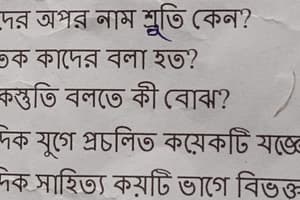Podcast
Questions and Answers
What is the time period of the Vedic civilization?
What is the time period of the Vedic civilization?
- 500 BCE - 1500 BCE
- 1500 BCE - 500 BCE (correct)
- 500 BCE - 1000 BCE
- 1000 BCE - 1500 BCE
Who is the god of thunder and war in Vedic mythology?
Who is the god of thunder and war in Vedic mythology?
- Mitra
- Agni
- Varuna
- Indra (correct)
What is the name of the primeval being from whom the universe was created in Vedic mythology?
What is the name of the primeval being from whom the universe was created in Vedic mythology?
- Agni
- Prajapati
- Varuna
- Purusha (correct)
What is the occupation of the Vaishya class in Vedic society?
What is the occupation of the Vaishya class in Vedic society?
What is the name of the oldest Vedic text, composed around 1500 BCE?
What is the name of the oldest Vedic text, composed around 1500 BCE?
What is the purpose of rituals and sacrifices in Vedic society?
What is the purpose of rituals and sacrifices in Vedic society?
What was the primary difference between the Indus Valley Civilization and Vedic Civilization?
What was the primary difference between the Indus Valley Civilization and Vedic Civilization?
Who proposed the European Theory of the origin of the Aryans?
Who proposed the European Theory of the origin of the Aryans?
According to the Asian Theory, where is the origin of the Aryans located?
According to the Asian Theory, where is the origin of the Aryans located?
Between which two consecutive civilizations did the post-Harappan Phase play a significant role?
Between which two consecutive civilizations did the post-Harappan Phase play a significant role?
What does the word 'Aryan' mean?
What does the word 'Aryan' mean?
Which region is associated with the scholar Ganga Nath Jha?
Which region is associated with the scholar Ganga Nath Jha?
What is the significance of the Boghaz-koi Inscriptions?
What is the significance of the Boghaz-koi Inscriptions?
What is the characteristic of the god Mitra?
What is the characteristic of the god Mitra?
What is the name of the region where the horse was domesticated around 3000 BC?
What is the name of the region where the horse was domesticated around 3000 BC?
What is the significance of the Kassite Inscriptions of 1600 BC and the Mitanni Inscriptions of the 14th century BC?
What is the significance of the Kassite Inscriptions of 1600 BC and the Mitanni Inscriptions of the 14th century BC?
Flashcards are hidden until you start studying
Study Notes
Vedic Civilization
Vedic Period Timeline
- 1500 BCE - 500 BCE: Vedic period, divided into Early Vedic (1500 BCE - 1000 BCE) and Late Vedic (1000 BCE - 500 BCE)
- Early Vedic: Characterized by the composition of the Rigveda, the oldest Vedic text
- Late Vedic: Saw the composition of other Vedic texts, such as the Yajurveda and Samaveda
Vedic Mythology
- Deities:
- Indra: God of thunder and war
- Agni: God of fire
- Varuna: God of the sky and the universe
- Mitra: God of friendship and contracts
- Cosmology:
- Purusha: The primeval being from whom the universe was created
- Prajapati: The creator god
- Mythological creatures:
- Asuras: Demons and anti-gods
- Nagas: Half-human, half-snake beings
- Rakshasas: Demons and monsters
Vedic Society and Culture
- Social hierarchy:
- Brahmins: Priests and teachers
- Kshatriyas: Warriors and rulers
- Vaishyas: Merchants and traders
- Shudras: Laborers and servants
- Economy:
- Agriculture: Main occupation
- Cattle rearing: Important for economy and rituals
- Family and marriage:
- Patriarchal society: Men held authority
- Monogamy: Common, but polygamy allowed for higher classes
Rigveda
- Oldest Vedic text: Composed around 1500 BCE
- Hymns and prayers: Addressed to various deities
- Mandala system: Divided into 10 mandalas, or chapters
- Rishis: Seers and poets who composed the hymns
- Rituals and sacrifices: Important for maintaining cosmic order and ensuring prosperity
Studying That Suits You
Use AI to generate personalized quizzes and flashcards to suit your learning preferences.




